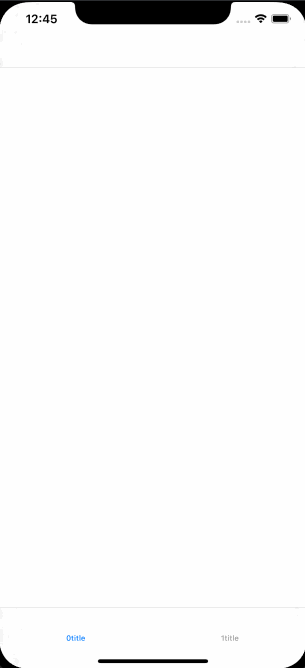一. UITabBarController
- 在使用初始化tabBarController的过程中,如果给其
set tabBarItems时像给其setViewControllers一样去set, (这样set viewControllers没问题,但是对于tabBarItems就有问题了)会报'Directly modifying a tab bar managed by a tab bar controller is not allowed.'这样的错误:
func application(_ application: UIApplication, didFinishLaunchingWithOptions launchOptions: [UIApplication.LaunchOptionsKey: Any]?) -> Bool {
let vc = ViewController( )
let tabBarVC = UITabBarController()
tabBarVC.viewControllers = [vc]
tabBarVC.tabBar.items = [UITabBarItem(tabBarSystemItem: .contacts, tag: 0)]
window = UIWindow(frame: UIScreen.main.bounds)
window?.rootViewController = tabBarVC
window?.makeKeyAndVisible()
return true
}
解决办法1:
func application(_ application: UIApplication, didFinishLaunchingWithOptions launchOptions: [UIApplication.LaunchOptionsKey: Any]?) -> Bool {
let vc = ViewController()
let tabBarVC = UITabBarController()
tabBarVC.viewControllers = [vc]
或者: tabBarVC.setViewControllers([vc], animated: false)
for i in 0..<[vc].count {
tabBarVC.tabBar.items?[i].image = nil
tabBarVC.tabBar.items?[i].title = "\(i)title"
}
// 这样子可以实现去set tabarItem
window = UIWindow(frame: UIScreen.main.bounds)
window?.rootViewController = tabBarVC
window?.makeKeyAndVisible()
return true
}
解决办法2:
func application(_ application: UIApplication, didFinishLaunchingWithOptions launchOptions: [UIApplication.LaunchOptionsKey: Any]?) -> Bool {
let vc = ViewController()
let tabBarVC = UITabBarController()
// 直接设置vc的tabBarItem, 其实这也是最友好最直观的一种处理方法
vc.tabBarItem = UITabBarItem(tabBarSystemItem: .contacts, tag: 0)
tabBarVC.setViewControllers([vc], animated: false)
window = UIWindow(frame: UIScreen.main.bounds)
window?.rootViewController = tabBarVC
window?.makeKeyAndVisible()
return true
}
遇到的坑1:
一开始做testDemo时想以最快的速度生成四个tabControllers, 于是这样写:
func application(_ application: UIApplication, didFinishLaunchingWithOptions launchOptions: [UIApplication.LaunchOptionsKey: Any]?) -> Bool {
let vc = ViewController()
let tabBarVC = UITabBarController()
let vcs = [vc, vc, vc, vc]
tabBarVC.setViewControllers(vcs, animated: false)
for i in 0..这样看起来没有错,但跑起来会报*** -[__NSSingleObjectArrayI objectAtIndex:]: index 1 beyond bounds [0 .. 0]越界的错误,原因是因为vcs里虽然有四个元素[vc, vc, vc, vc], 但它们是同一个vc, 对于tabBarController来说它们是同一个,这时候tabBarController给它们创建的item就只会有一个,因此在for i in 0..
修改方法:
let vc1 = ViewController()
let vc2 = ViewController()
let vc3 = ViewController()
let vc4 = ViewController()
let vcs = [vc1, vc2, vc3, vc4]
let tabBarVC = UITabBarController()
tabBarVC.setViewControllers(vcs, animated: false)
for i in 0..这样创建了4个不同的vc,传到tabBarController里时才会是四个独立的vc而不会越界。
遇到的坑2:配合NavigationController使用时
想要配合导航栏使用,于是这样写:
func application(_ application: UIApplication, didFinishLaunchingWithOptions launchOptions: [UIApplication.LaunchOptionsKey: Any]?) -> Bool {
let vc = ViewController()
let tabBarVC = UITabBarController()
vc.tabBarItem = UITabBarItem(tabBarSystemItem: .contacts, tag: 0)
tabBarVC.setViewControllers([vc], animated: false)
window = UIWindow(frame: UIScreen.main.bounds)
window?.rootViewController = UINavigationController(rootViewController: tabBarVC)
window?.makeKeyAndVisible()
return true
}
看起来似乎没有什么问题,但跑起来后会发现: 即使我在ViewController里手动设置了title,但模拟器上的导航栏仍然不会显示title
class ViewController: UIViewController {
override func viewDidLoad() {
super.viewDidLoad()
title = "ViewController1"
//或者换成: navigationItem.title = "ViewController1" 亦然
view.backgroundColor = .white
}
或者在外面创建这个navigationController时给其写上title,亦然不成功显示:
let nav = UINavigationController(rootViewController: tabBarVC)
nav.navigationItem.title = "444"
//或者 nav.title = "444" 亦然
window = UIWindow(frame: UIScreen.main.bounds)
window?.rootViewController = nav
window?.makeKeyAndVisible()
而且这些处理方法还有可能会触发底部的tabBarItem的title变化, 比如
func application(_ application: UIApplication, didFinishLaunchingWithOptions launchOptions: [UIApplication.LaunchOptionsKey: Any]?) -> Bool {
let vc1 = ViewController()
let vc2 = ViewController()
let tabBarVC = UITabBarController()
let vcs = [vc1, vc2]
tabBarVC.setViewControllers(vcs, animated: false)
for i in 0..需要解决这个tabBarItem的title变化的问题可以将ViewController里的title = "ViewController1"换成navigationItem.title = "ViewController1", 但这样仍然解决不了导航栏不显示tittle的问题;
解决办法
创建相应的子控制器(viewControllers)(子视图,新建自己需要的UIViewController或者UITableViewController等等, 如果需要组合使用UINavigationController, 需要将这些视图作为UINavigationController的根视图,使用initWithRootViewController创建nav, 然后再将这些nav做成tabBarController的viewControllers)
func application(_ application: UIApplication, didFinishLaunchingWithOptions launchOptions: [UIApplication.LaunchOptionsKey: Any]?) -> Bool {
let vc1 = ViewController()
let vc2 = ViewController()
let tabBarVC = UITabBarController()
let nav1 = UINavigationController(rootViewController: vc1)
let nav2 = UINavigationController(rootViewController: vc2)
tabBarVC.setViewControllers([nav1, nav2], animated: false)
...
...
window = UIWindow(frame: UIScreen.main.bounds)
window?.rootViewController = tabBarVC
window?.makeKeyAndVisible()
return true
}
这时候在ViewController设置自己的`navigationItem.title = ""`就可以了,(注意: 不能直接self.title = "",这样会设置更新到tabBarItem的title)
假如要在外面(AppDelegate或者tabBarController去设置每一个子vc的title,)可以在创建子vc的时候:
子vc.navigationItem.title = “vc1”...
如果有navgation, 用nav.title/nav.navigationItem.title都是不行,一定要用vc.navigationItem.title = “vc1”...才会正常显示
遇到的坑2:
在给tabBarItem设置字体或者字体颜色时遇到了给title selected 状态的字体时无效的问题。
如图,想要设置在选中状态时字体不同:
tabBar.tintColor = .textBrand
tabBar.unselectedItemTintColor = .textDefault
UITabBarItem.appearance().setTitleTextAttributes([NSAttributedString.Key.font: UIFont.caption1], for: .normal)
UITabBarItem.appearance().setTitleTextAttributes([NSAttributedString.Key.font: UIFont.body], for: .selected)
理想是这样的,但发现无论怎么弄,在给selected状态设置的字体都不生效,最后找到的解决办法是在其点选的代理方法中修改:
{
...
tabBar.tintColor = .textBrand
tabBar.unselectedItemTintColor = .textDefault
...
}
override func tabBar(_ tabBar: UITabBar, didSelect item: UITabBarItem) {
tabBar.items?.forEach {
if $0 != item {
$0.setTitleTextAttributes([NSAttributedString.Key.font: UIFont.caption1], for: .normal)
}
}
item.setTitleTextAttributes([NSAttributedString.Key.font: UIFont.body], for: .normal)
//既然设置selected 状态无效,而normal有效,那么我们就都设置成normal,区分开选中与不选中来单独设置
}
这样写完发现点选过程中可以实现预期效果了,但还有一个问题,第一次进入这个页面时默认选中第一个,且这时候并不会调用这个代理方法,这样就会使用第一次进入时第一个被选中但字体却不是我们想要的。
所以,这里还需要手动去调用一下这个方法:
//在设置tintColor处加上这句就可以了
self.tabBar(self.tabBar, didSelect: navHome.tabBarItem)
参考: iOS 设置 tabbar 选中状态字体大小

